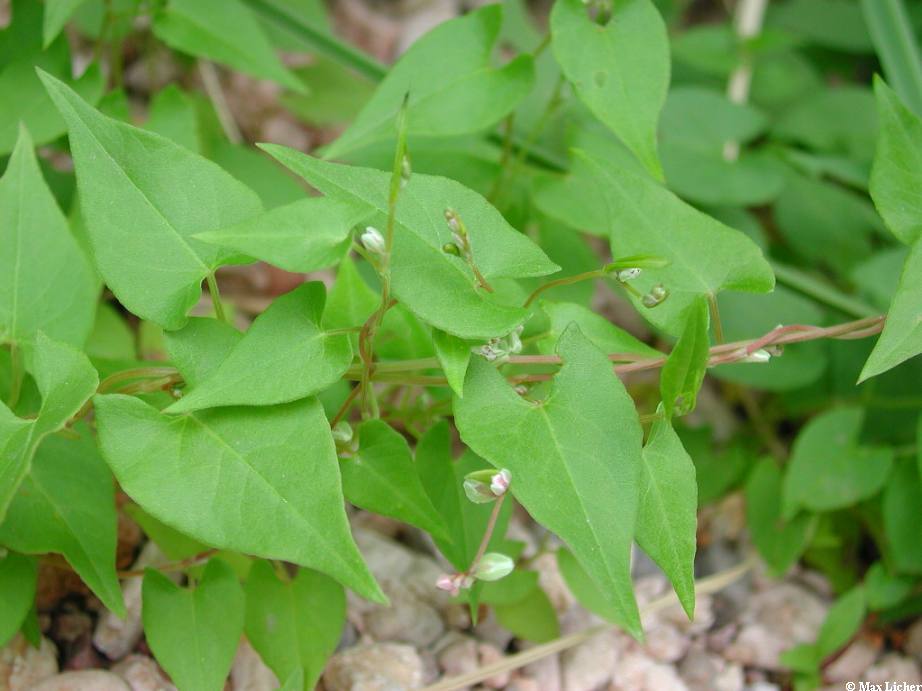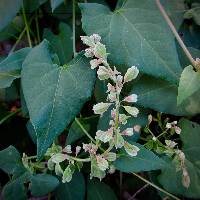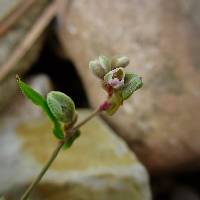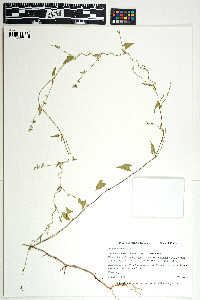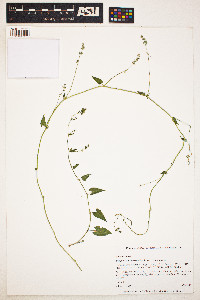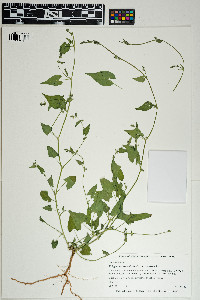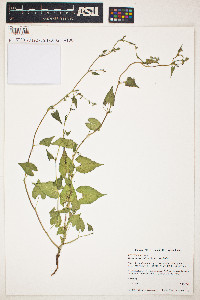|
|
|
|
Family: Polygonaceae
black bindweed, more...black bindweed
[Bilderdykia convolvulus (L.) Dumort., morePolygonum convolvulus L., Polygonum convolvulus var. convolvulus , Reynoutria convolvulus (L.) Shinners, Tiniaria convolvulus (L.) Webb & Moq.] |
Herbs, annual, not rhizomatous, 0.5-1 m. Stems scandent or sprawling, branched proximally, herbaceous, puberulent, sometimes mealy, not glaucous. Leaves: ocrea persistent or deciduous, tan or greenish brown, cylindric, 2-4 mm, margins oblique, face not fringed with reflexed hairs and slender bristles at base, otherwise glabrous or scabrid; petiole 0.5-5 cm, puberulent in lines; blade cordate-ovate, cordate-hastate, or sagittate, 2-6(-15) × 2-5(-10) cm, base cordate, margins wavy, scabrid, apex acuminate, abaxial face usually mealy and, rarely, minutely dotted, not glaucous, adaxial face glabrous. Inflorescences axillary, erect or spreading, spikelike, 2-10(-15) cm, axes puberulent; peduncle 0.1-10 cm or absent, glabrous or scabrid distally in lines. Pedicels ascending or spreading, articulated distally, 1-3 mm, glabrous or, rarely, scabrid. Flowers bisexual, 3-6 per ocreate fascicle; perianth nonaccrescent, greenish white, often with pinkish or purplish base, 3-5 mm including stipelike base, glabrous or outer 3 with blunt, hyaline hairs; tepals elliptic to obovate, apex obtuse to acute, outer 3 obscurely keeled; stamens 8; filaments flattened proximally, glabrous; styles connate distally; stigmas capitate. Achenes included, black, 4-5(-6) × 1.8-2.3 mm, dull, minutely granular-tuberculate, especially on faces; fruiting perianth glabrous or with blunt, hyaline hairs, wings absent or, rarely, flat to undulate, 0.4-0.9 mm wide at maturity, scarcely decurrent on stipelike base, margins entire. 2n = 40. Flowering May-Oct. Cultivated ground, waste places; 0-2700 m; introduced; Greenland; St. Pierre and Miquelon; Alta., B.C., Man., N.B., Nfld. and Labr., N.S., Ont., P.E.I., Que., Sask., Yukon; Ala., Alaska, Ariz., Ark., Calif., Colo., Conn., Del., D.C., Fla., Ga., Idaho, Ill., Ind., Iowa, Kans., Ky., La., Maine, Md., Mass., Mich., Minn., Miss., Mo., Mont., Nebr., Nev., N.H., N.J., N.Mex., N.Y., N.C., N.Dak., Ohio, Okla., Oreg., Pa., R.I., S.C., S.Dak., Tenn., Tex., Utah, Vt., Va., Wash., W.Va., Wis., Wyo.; Eurasia; introduced in South America (Argentina, Chile), Africa (Algeria, Morocco, Republic of South Africa), Pacific Islands (Hawaii, New Zealand), Australia. Fallopia convolvulus can be an aggressive weed in crop fields. Rare plants with winged fruiting perianths have been named var. subalata; that characteristic often varies within populations.
Trailing or twining annual to 1 m; stem, petioles, and often the lf-veins scabrellate in lines; lvs sagittate to triangular-cordate, ocreae smooth; racemes interrupted, naked or with a few small lvs at base, 2-6 cm; fls in clusters of 3-6; pedicels 1-2 mm, jointed above; perianth 1.5-2 mm, green outside, white inside; achene dull black, 3-4 mm, closely invested but not exceeded by the perianth; outer tep often with narrowly winged midrib; styles united; 2n=20, 40. Roadsides, railways, and waste ground throughout our range; native of Europe. May-Oct. (Bilderdykia c.; Tiniaria c.) Gleason, Henry A. & Cronquist, Arthur J. 1991. Manual of vascular plants of northeastern United States and adjacent Canada. lxxv + 910 pp. ©The New York Botanical Garden. All rights reserved. Used by permission. Martin and Hutchins 1980, Kearney and Peebles 1969 Duration: Annual Nativity: Non-Native Lifeform: Vine General: Rough stemmed annual, stems twining, often procumbent when young. Leaves: Blades ovate to ovate-lanceolate, cordate to sagittate at the base, acuminate at the apex; sheaths entire on the margins. Flowers: In interrupted spikelike racemes or short axillary clusters; flowers greenish or purple tinged; calyx sometimes purple tipped, puberulent, 3-4 mm long, outer lobes keeled in fruit. Fruits: Achenes 3-angled, dull black, minutely roughened. Ecology: Found on disturbed ground from 4,500-8,000 ft (1372-2438 m); flowers May-August. Notes: The twining stems are distinctive. Ethnobotany: Unknown, but other species in this genera have uses. Etymology: Polygonum is derived from Greek polys, many, and gonu, knee or goint, while convolvulus is from the Latin convolvere, to twine around. Synonyms: None Editor: SBuckley, 2010 |


